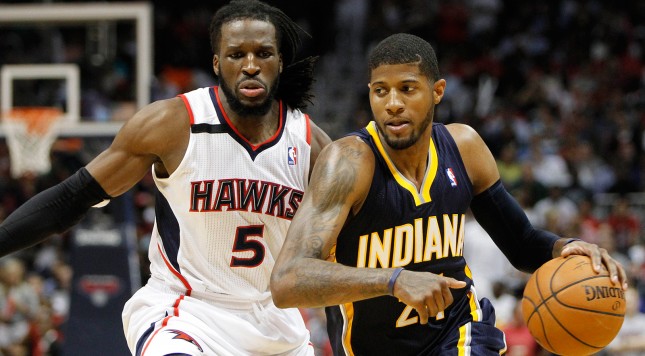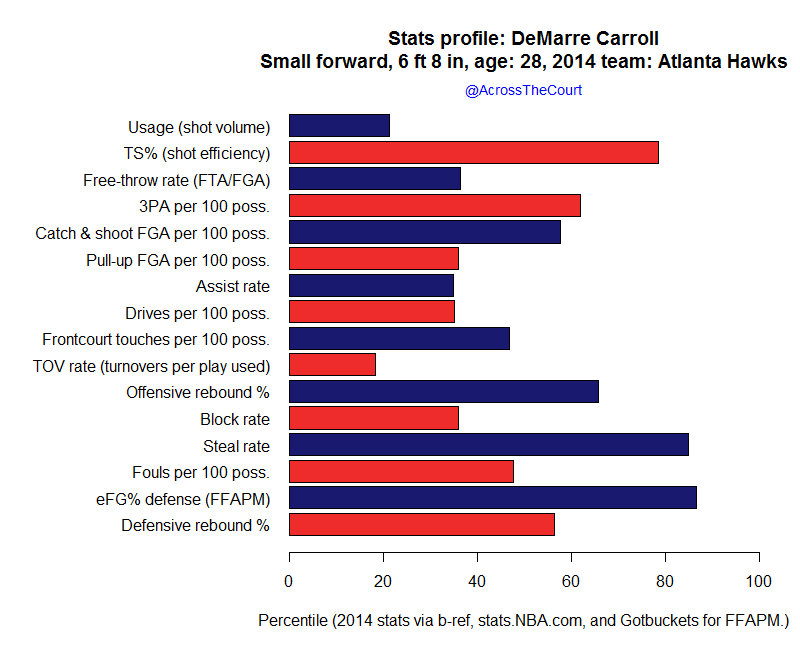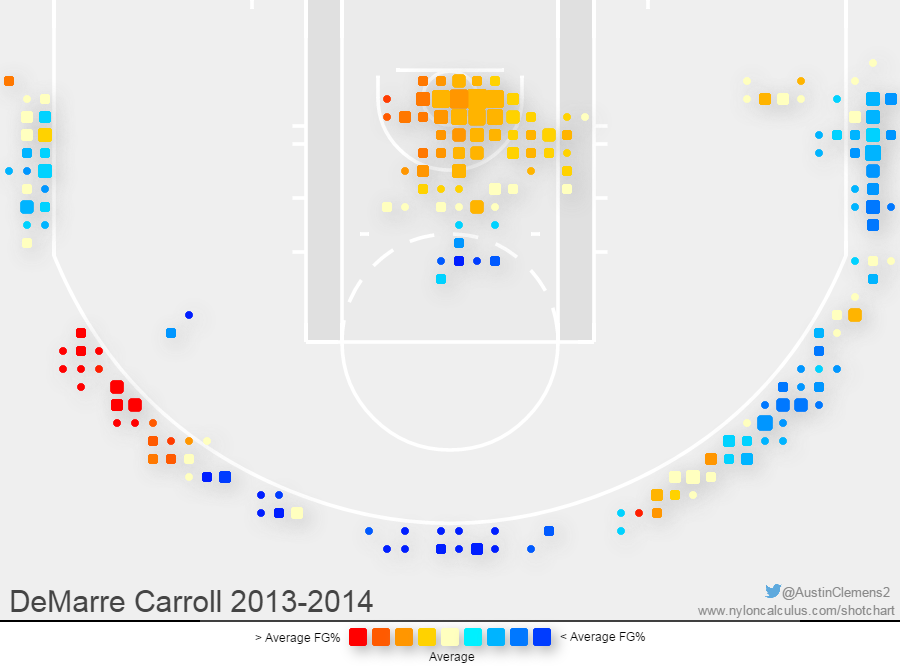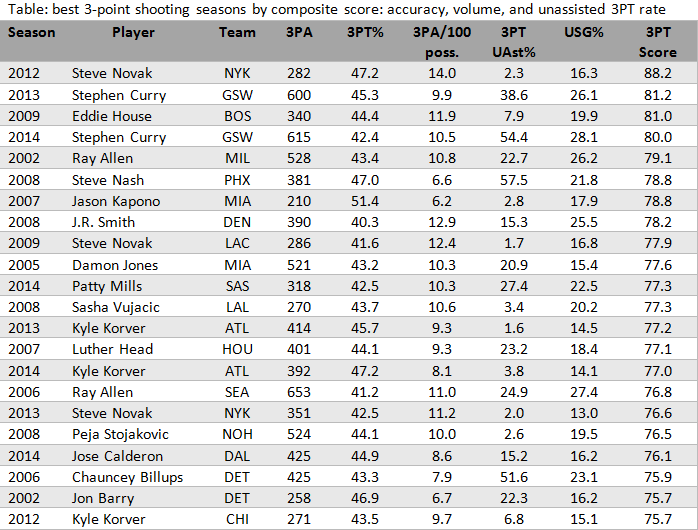Atlanta has an unfortunate off-season with insensitive remarks from General Manager Danny Ferry, but I hope this won’t dissuade people from the team, which is subtly unconventional and the highest paid player, Horford, is only getting 12 million dollars a year. Atlanta has had trouble finding relevancy for years, but there’s an opportunity here to build something special.
2014 in review
After signing Paul Millsap to a ridiculously small contract, Atlanta entered the season with hope, but Al Horford tore his right pectoral muscle — just a couple years after tearing his left pectoral muscle. They hung around admirably but suffered an awful 1-14 stretch where they lost big men Millsap, Antic, and Ayon at various points — they actually lost Al, their starting center, and Antic, their backup center, at the same time. They managed to play fine without Horford due to their depth, but once two or three other big men went out it was too much to handle. But incompetence was common in the east and they made the playoffs anyway, giving the slumping Pacers a good fight before bowing out.
Changes
Exit: Louis Williams, Cartier Martin, Gustavo Ayon, James Nunnally, Jared Cunningham.
Enter: Thabo Sefolosha, Kent Bazemore, Adriean Payne.
There are few major changes to the team. It’s essentially the same roster with Thabo Sefolosha instead of Lou Williams. Thus, expect them to be a little better on defense and a little worse on offense, before factoring in a healthy Al Horford. Ayon had an injury-plagued season. He’s played well in the NBA, but it’s been in limited minutes on a couple different teams and he’s leaving for a larger role in Europe. Bazemore, like Thabo, is known for his defense, and as a high-volume three-point shooter he fits in well. Payne, a power forward, was selected 15th, but he probably won’t play much.
Player spotlight
DeMarre Carroll emerged as a starter late in his career after small roles on four different teams, and immediately carved out a role on Atlanta as their 3/D specialist at small forward. This is apparent from the graph below as Carroll is a low usage player who takes a lot of three-pointers — over 40% of his field goals, in fact. But he’s not a statue on offense either, only standing in the corner. He has good offensive rebound rate given his outside shooting proclivities, can pull-up for a shot, drives sometimes, and has an okay free-throw rate. And as an ideal role player, he’s an efficient shooter and his turnovers are infrequent.
Defense is DeMarre’s calling card and the stats bear it out. He is ranked in the 80’s in percentile with both steals and eFG% defense. His foul rate is average, which is good for a defensive specialist because it allows him to stay on the court for long stretches. Unlike a lot of other small forwards, he probably shouldn’t be used as a stretch 4 because his defensive rebounding wouldn’t be strong enough and he’s not a shotblocker.
Carroll’s shot chart has some classical beauty to it. He shoots equally around the entirety of the three-point line, encircling a wide swath of orange near the rim. This is new, however, because before Atlanta he was shooting a fair amount of long two-pointers. Houston is the popular choice as an example of the new shot selection paradigm in the league, but Atlanta is just as extreme and instead of Dwight Howard they have centers who can shoot from 20 feet and further. One warning is that there’s a chance Carroll’s three-point percentage is a fluke because he’s never been a reliable outside shooter, but at least he’s well above average at finishing around the rim and always has been.
Carroll’s offensive game is featured below (link’s also here) in a game against Golden State. In the first video, his defender Iguodala gets pinned by Millsap a few feet away and DeMarre hits an open three. He’s not a standstill shooter, jumping high as he shoots, and he has a high release. He runs the break well too, scoring in transition in the second video. In the third video, he ends up standing around in the corner doing nothing, a problem with a lot of specialists, but this isn’t his weakness and he rectifies it. He quickly cuts to the rim when the defender isn’t paying attention and gets an easy shot. In the fourth video he shoots a rare midrange jumper. And lastly, when Iguodala is helping out on a drive DeMarre is wide open from the corner. Iguodala hustles back to chase him off the line, the right move, but DeMarre puts the ball on the floor and scores at the rim with the elite defender on his heel. That ability separates him from many other one-dimensional role players.
Given the most difficult defensive assignments on the wing, DeMarre Carroll can be seen matched-up against Kevin Durant in the playlist below (link’s also here.) In the first clip, DeMarre fights through screens and sets up as Durant posts him up from 15 feet. As Durant tries to back him down, DeMarre slaps the ball away and causes a turnover, showing his quick hands. At the end of the second video, Durant tries to accelerate past him using a pick from way outside the three-point in, but Carroll pushes his way through and helps to Durant, who loses the ball and leads to a Carroll fast break. The third video is short and shows Carroll bat down a pass from Durant as he stays on his hip on a drive. Durant’s last turnover, the fourth video, can’t directly be tied to DeMarre, but it’s important to note he got the full defensive assignment on the MVP and was guarding him during every one of his turnovers.
DeMarre Caroll is an unheralded 3/D specialist, an excellent but overlooked defender who received as many votes for the NBA all-defensive team as Kemba Walker and only one more than Danny Granger. (Since James Harden got two votes, there’s a real possibility some of these votes were errors.) He’s also the prototypical energy guy, active on offense by driving, cutting, and sometimes crashing the boards. His three-point percentage should be taken with a grain of salt, although his career percentage is 39% on two-pointers beyond 16 feet. He was the underrated cog in Atlanta’s success in staving off disaster when Horford went down, and the Hawks will begin the season with a balanced, full starting lineup.
2015 projected
The Hawks are returning with mainly the same cast, and obviously the biggest difference is Horford. The amount that they can improve this season largely depends on how valuable he actually is, thinking of this in a vacuum and in the context of the surrounding personnel. We can’t point back to their pre-2014 seasons with him because of how different they are with Josh Smith at power forward and the absence of Millsap and DeMarre Carroll. Naturally, the most straightforward way of answering this question is to look at how well they did when Horford was playing. In their 29 games with him, they outscored opponents by 2.2 points per game; without him they were outscored by 1.9 points per game. This aligns with the perception of the team as one in the mid-40’s win range. Their defense was mainly the problem, dropping by three points per 100 possessions — Horford is a solid defender and they resorted to smaller lineups without him. Based on their schedule, through the first 29 games the Hawks played like a 45-win team.
Of course, we’re only working with 29 games. Strictly speaking the math isn’t that simple and there are plenty of examples of teams that play significantly different in the first half of the season — sorry, Indiana. Based on the information I have, Al Horford over a full season is basically a fringe all-star level player, which jives with reality; he probably wouldn’t have been invited to the all-star games in a tougher conference and if he didn’t have easier competition at center. Replacement level zealots will point to Horford being an 8 to 10 win player at full strength, but we can’t directly add those in. Players like Mike Scott and Brand filled his displaced minutes, averaging about ten minutes more a game after he went down, while Mike Muscala only payed late in the season, and how much Horford will help the team will be based on how you rate players like them.
Elsewhere, there will be little uncertainly. Paul Millsap had a career season, confirming the prophesies and making it to the all-star team not too long after being stuck on the bench with people wondering about how good he actually was. Atlanta would be happy if he simply executed a perfect reenactment last season. A do-it-all power forward who had no immediately identifiable strengths but few weaknesses, his new three-point proficiency gives the Hawks a powerful weapon.
DeMarre Carroll was profiled earlier, and he’s a perfect complement for Korver as a high-energy, athletic defender. Korver is actually an underrated defender, as his teams fare fine and often play better defense when he plays. In two extremely intriguing stats from SportVU, Korver ranks fourth in the entire league, after Durant, Carmelo, and Paul George, in what’s dubbed the “gravity score” for how much a player distorts the opposing team’s defense, and he rates first overall in distraction, which tracks how often a defender strays from the player, like to help guard someone else — defenses can’t leave Korver alone, and for good reason. He’s an evolutionary Reggie Miller, using a maze of screens to find an open shot and as the current record holder in single season three-point percentage there’s a fear in letting him have a sliver of daylight. He led the league on SportVU’s catch-and-shoot three-point percentage at 50%, which translates into an offensive efficiency that crushes opposing defenses. If it weren’t for Stephen Curry reinventing what three-point shooters can do, we’d be marveling at his skill and his sterling record.
Last season Korver shot 47% on three-pointers on a high volume, surely one of the best displays of outside shooting we’ve ever seen. But where does it rank, and which Korver season is best? I created a simple metric for this, combining volume and accuracy by dividing those values by an upper bound with an adjustment for unassisted three-pointers. (Explanation: Korver holds the record at 53.6%, so I set the upper bound at 55%. Thus, if you shoot 40%, you divide it by 55. I adjust unassisted three-pointers by assuming they’re 7% harder, add the volume and accuracy values, and standardize it to a 100-point scale.) The best three-point shooting seasons since 2001 with at least 200 attempts, according to that simple metric, are shown below.
Novak’s 2012 season is in a class of its own with astounding volume and an extremely high conversion rate. Curry’s vaunted 2013 season is second, thanks to a deadly combination of accuracy, volume, and a high unassisted rate. One may still argue Curry’s season is better since he was on the court more and the difficulty of his shots may have been underestimated by his unassisted rate. Korver’s recent season is the 15th best and two of his others crack the top 25. Korver’s record-breaking season of 53.6%? It didn’t have enough attempts, but it scored 81.2, and a hundredth of point under Curry’s best season. (Fun little aside: Josh Smith’s 2014 season rates as the worst.)
Jeff Teague signed a long contract with Atlanta at 8 million dollars a year. Usually these deals for young guys become bargains, but Teague has stalled as a player. He’s an okay player who shot more last season, taking a larger role without Horford, and nets a high number of assists. But he’s neutral everywhere else, and overall he’s nothing more than an average starter at best, but in the golden age of point guard depth it looks like a weakness.
Atlanta took a flier on Sefolosha, buying low after a season where he seemingly lost the ability to shoot. Due to the Meeks rule — named after Jodie Meeks and his two very different seasons with the Lakers — we can expect role players who have a sudden drop in three-point percentage to rebound to their historical averages, or above, the next season. He was genuinely a candidate for an all-defense team at least in 2013, and with his long arms, quickness, and ability to harass players without fouling he’s a great counter to Carroll and gives Atlanta more defensive firepower.
Thabo joins a bench that’s a little shallow now. With Lou Williams gone, there’s no reliable back-up point guard. Schroder could not shoot last season and the team was vastly worse on defense when he played. Shelvin Mack is more of a third string point guard than second string. The surprise last year was forward Mike Scott, who showed good scoring skills, but may not receive major minutes due to the logjam at power forward with Millsap and maybe even Horford demanding time there. Pero Antic was a great find, if a bit unorthodox: were it not for Prigioni, he would have been the oldest rookie ever. The poor man’s Mehmet Okur and a ringer for a Hollywood villain, Antic’s love of jacking of three-pointers plays to a strength of the team and confounds defenses. Elton Brand’s the sole big man without 20 foot range, and Atlanta’s five-out offenses can throw a wrench in the elaborate defensive machinations of the league’s best like the Pacers.
Summary
The Hawks have a pretty rosy financial roster sheet, and they’re one big name from being a real powerhouse. They have all the parts — a couple of solid scorers, a top-notch shooter, and a bevy of stretch big men — for a really interesting contender. They’re just missing the superstar, which is admittingly the most important piece. It’s enough to make the playoffs in the east, even without Horford for most of the season. The goal will probably be avoiding the 8th seed as the dreaded Cleveland speed bump and preferably a top 6 seed in case the Bulls are back. My ratings don’t like three of their guards — Schroder, Jenkins, and Bazemore — and I was cautious in giving Al Horford minutes. If he’s healthy and their guards improve, they could hit the 45-win pace they started last year, but my conservative guess is just a hair over 0.500low 40’s.
Wins: 41
Losses: 41
Conference rank: 6th
League offense rank: 22nd
League defense rank: 6th
Edited 10/27/14























